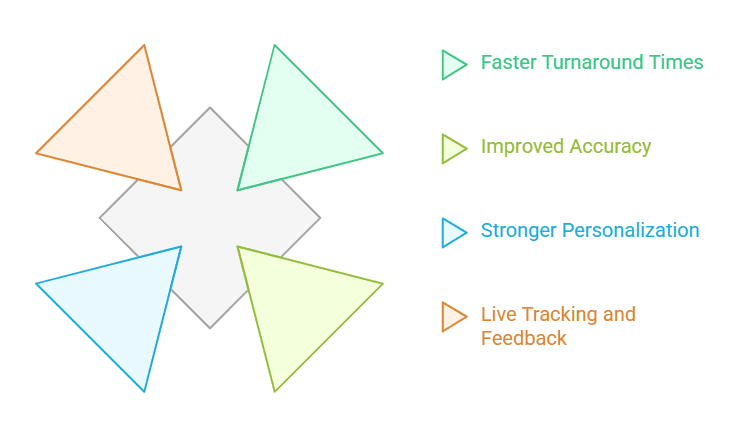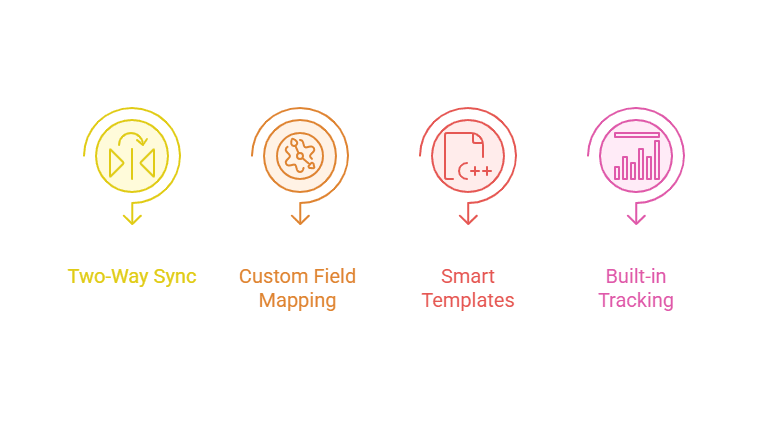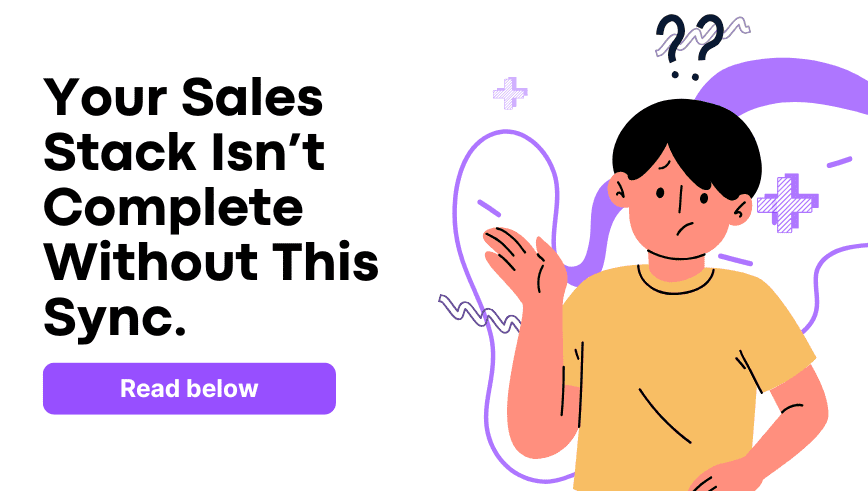"إذا قمت بعمل شيء ممتع، فسيجد المستخدمون طريقة لجعله ضروريًا."
— ستيوارت باترفيلد، المؤسس المشارك لشركة سلاك
يعكس هذا الاقتباس تطور معظم الأدوات الحديثة: من كونها اختيارية إلى أن تصبح لا غنى عنها. بالنسبة لمعظم الشركات اليوم، هذا ما أصبح عليه نظام إدارة علاقات العملاء (CRM). فهو أساس كيفية إدارة الفرق لعلاقات العملاء، وتتبع مسارات العمل، وتحديد أولويات العمل. لكن القيمة الحقيقية تكمن عندما لا يعمل نظام إدارة علاقات العملاء بمفرده.
في Proposal.biz، عملنا مع شركات من مختلف القطاعات، ولدينا نمط واحد ثابت. مع أن إدارة علاقات العملاء (CRM) ضرورية، إلا أن فعاليتها تتوقف على الأدوات المرتبطة بها. من بين هذه الأدوات، لا يؤثر أي منها بشكل مباشر على سرعة الصفقات مثل برامج عروض الأسعار. يساعد دمج برامج عروض الأسعار مع إدارة علاقات العملاء (CRM) فرق المبيعات على العمل بشكل أسرع، والاستجابة بشكل أذكى، وإتمام الصفقات بثقة أكبر.
لماذا يستحق هذا التكامل اهتمامًا جديًا
تحتوي أنظمة إدارة علاقات العملاء (CRM) على معلومات حيوية عن العملاء والصفقات: الملاحظات، ونقاط التواصل، وسجل التسعير، والتفضيلات. لكن العروض تبقى في المرحلة الأخيرة من رحلة العميل. يجب أن يعمل الطرفان بتناغم. فبدون التكامل، تضطر فرق المبيعات إلى نقل التفاصيل يدويًا من نظام إدارة علاقات العملاء إلى العروض، مما يزيد من احتمالية حدوث أخطاء وضياع الوقت.
يُحلّ دمج برنامج العروض مع نظام إدارة علاقات العملاء (CRM) هذه المشكلة بإنشاء سير عمل موحّد. فهو يُلغي التكرار، ويُملأ الحقول المهمة تلقائيًا، ويُوازي تنسيق العرض مع توقعات العميل. عندما يتكامل برنامج العروض مع نظام إدارة علاقات العملاء، تُصبح العروض أكثر ملاءمةً، وتُرسَل بشكل أسرع، وتُعكس البيانات في الوقت الفعلي. نوع الاقتراح كما أن عملية إنشاء هذا التكامل تؤثر أيضًا على مدى قيمته.
والأمر الأكثر أهمية هو أن دمج برامج الاقتراحات مع نظام إدارة علاقات العملاء يضمن أن يصبح إنشاء الاقتراحات جزءًا من تدفق المبيعات الطبيعي بدلاً من الشعور بأنه مهمة منفصلة.
لهذا السبب، تبحث المزيد من الشركات عن برامج مقترحات إدارة علاقات العملاء (CRM) متكاملة وجاهزة للاستخدام. لأن الوقت الموفر والدقة المعززة تتزايدان مع كل دورة صفقة.
لماذا تُعدّ التكاملات المُركّزة على الاقتراح أكثر أهمية من غيرها
هناك العديد من الأدوات التي تتكامل مع نظام إدارة علاقات العملاء (CRM): برامج البريد الإلكتروني، وتطبيقات التقويم، وبرامج إدارة المهام. لكن برامج العروض لها أهمية مختلفة. فهي لا تُدير التواصل فحسب، بل تُمثل عروض أعمالك، وتُحدد السعر والنطاق والجداول الزمنية.
عند دمج برنامج عروض الأسعار، يُساعد ذلك فرق المبيعات على إنشاء مستندات سياقية، تتوافق مع العلامة التجارية، وفي الوقت المناسب. يختفي خطر أخطاء الإصدارات أو التسعير القديم. لذلك، يُعتبر دمج برنامج عروض الأسعار مع نظام إدارة علاقات العملاء (CRM) أمرًا ضروريًا، وليس اختياريًا.
بناءً على خبرتنا، غالبًا ما تقوم الشركات التي تعطي الأولوية لهذا التكامل في وقت مبكر بإنشاء أنظمة مبيعات أكثر كفاءة وقابلة للتطوير من البداية.
حالات الاستخدام الواقعية عبر الصناعات
قيمة تكامل إدارة علاقات العملاء يصبح الأمر أكثر وضوحًا عند النظر إلى حالات الاستخدام العملية. إليك كيفية دمج برامج العروض مع أنظمة إدارة علاقات العملاء في مختلف القطاعات:
شركات SaaS
تتعامل شركات البرمجيات كخدمة (SaaS) عادةً مع مستويات الاشتراك وعروض الأسعار المخصصة والتجديدات. مع دمج برنامج إدارة علاقات العملاء (CRM)، تُنشأ جداول الأسعار ودورات التجديد تلقائيًا بناءً على بيانات العميل. هذا يُخفف من حدة الارتباك ويُسرّع اتخاذ القرارات.
الوكالات والاستشاريين
يختلف النطاق والمخرجات والأسعار باختلاف العميل. تتيح الأنظمة المتكاملة لمقدمي الخدمات إعداد عروض مخصصة باستخدام ملاحظات الاستكشاف المخزنة في نظام إدارة علاقات العملاء (CRM)، والملاحظات السابقة، ونماذج الفوترة.
التجارة الإلكترونية والتصنيع
تعتمد العديد من عمليات التصنيع والتجارة الإلكترونية على تسعير إقليمي وخيارات متنوعة للمنتجات. تتكيف العروض ديناميكيًا باستخدام بيانات إدارة علاقات العملاء، مثل سجل الطلبات والموقع والخصومات المقدمة.
فرق مبيعات B2B
في مختلف القطاعات، غالبًا ما تكون وتيرة إنجاز الصفقات التجارية بين الشركات بطيئة. يضمن أتمتة عروض المبيعات باستخدام بيانات إدارة علاقات العملاء (CRM) استجابات أسرع ومتابعة مستمرة، مما يُحسّن سرعة إتمام الصفقات بشكل عام.
يؤدي دمج برامج الاقتراح مع إدارة علاقات العملاء في كل من هذه البيئات إلى التنبؤ بشكل أكثر ذكاءً، وتخطيط أفضل للموارد، وتحسين الاحتفاظ بالعملاء.
فوائد دمج برنامج العروض مع نظام إدارة علاقات العملاء

لا يقتصر هذا التكامل على الاستغناء عن الجهد اليدوي فحسب، بل إن فوائده تتجاوز ذلك بكثير:
- أوقات استجابة أسرع: يمكن إنشاء المقترحات في دقائق، مما يحافظ على الزخم الذي تم بناؤه أثناء محادثات المبيعات.
- تحسين الدقة: بفضل تدفق البيانات مباشرةً من نظام إدارة علاقات العملاء، تكون أسماء العملاء والأسعار والجداول الزمنية صحيحة دائمًا.
- تخصيص أقوى: يمكن لحقول إدارة علاقات العملاء مثل الصناعة أو آخر منتج تم شراؤه أو المنطقة أن تساهم في تقديم مقترحات مخصصة دون بذل جهد إضافي.
- التتبع المباشر وردود الفعل: يمكنك معرفة متى تم فتح الاقتراح، ومدة عرضه، أو إذا تمت إضافة تعليقات، كل ذلك من داخل لوحة معلومات CRM.
إن فوائد دمج برامج العروض مع نظام إدارة علاقات العملاء تتجاوز مجرد الراحة، بل تُحسّن تجربة الشراء بأكملها، من المكالمة الأولى إلى توقيع العقد.
لماذا تتساءل الشركات عن كيفية ربط برامج العروض ببرنامج إدارة علاقات العملاء (CRM)
تتساءل العديد من الشركات عن كيفية ربط برامج العروض بنظام إدارة علاقات العملاء (CRM) دون زيادة تعقيدها. يكمن الحل في منصات تُعطي الأولوية لتجربة المستخدم، وتُمكّن من ربط الحقول بالسحب والإفلات، وتدعم المزامنة المباشرة دون الحاجة إلى واجهات برمجة تطبيقات مخصصة. عند تنفيذها بشكل صحيح، لا يتطلب هذا الإعداد سوى القليل من التدريب، ويُقدم قيمة فورية.
اختيار برنامج متكامل لإدارة علاقات العملاء (CRM) منذ البداية يُسهّل هذه الرحلة. يمكن للفرق رؤية النتائج في غضون أسبوع واحد فقط، بفضل قوالب أنيقة وسير عمل متزامنة تُعزّز كل عرض سعر.
الميزات التي يجب البحث عنها في التكامل الجيد

لا تتكامل جميع أدوات الاقتراحات بنفس الطريقة. بعضها يوفر مزامنة أحادية الاتجاه فقط، بينما يوفر بعضها الآخر اتصالاً أعمق. إليك الميزات الأساسية التي يجب على الشركات البحث عنها:
المزامنة ثنائية الاتجاه
ينبغي للمقترحات سحب البيانات من نظام إدارة علاقات العملاء ودفع تحديثات الحالة وسجلات النشاط والنتائج مرة أخرى إلى نظام إدارة علاقات العملاء.
تعيين الحقل المخصص
غالبًا ما تستخدم الشركات حقول إدارة علاقات العملاء (CRM) مخصصة وفريدة من نوعها في قطاعها. ينبغي أن يسمح التكامل الموثوق بملء هذه الحقول تلقائيًا.
القوالب الذكية
يجب أن تتضمن القوالب حقولاً ديناميكية مثل {{client_name}} أو {{deal_value}} أو {{renewal_date}}، مما يجعل كل اقتراح يبدو مخصصًا.
التتبع المدمج
يجب أن تكون أنشطة الاقتراح مثل الفتح أو النقر أو التعليقات مرئية داخل نظام إدارة علاقات العملاء، مما يوفر رؤى مفيدة لمتابعة المبيعات.
هذه الإمكانيات هي ما يميز أفضل برامج عروض الأسعار المتوافقة مع أنظمة إدارة علاقات العملاء (CRM) عن العروض الأساسية. كما تستفيد الفرق التي تُولي أهمية كبيرة لدمج برامج عروض الأسعار مع أنظمة إدارة علاقات العملاء (CRM) من اتساق العلامة التجارية والتحكم في الإصدارات طوال دورة الصفقة.
الأخطاء التي يجب تجنبها عند التكامل
في حين أن الفوائد واضحة، هناك بعض الأخطاء الشائعة التي رأينا الشركات ترتكبها عند ربط أنظمة إدارة علاقات العملاء (CRM) وأنظمة العروض الخاصة بها لأول مرة:
- التسرع دون نظافة البيانات: يجب أن تكون سجلات CRM نظيفة ومحدثة قبل المزامنة.
- نسيان اختبار القوالب: يجب اختبار القوالب باستخدام بيانات CRM المباشرة لتجنب أخطاء التنسيق.
- تخطي تدريب المستخدم: حتى أفضل عمليات التكامل قد لا تحقق أداءً جيدًا إذا لم يتم تدريب الفرق.
- تجاهل تخطيط الحقول: تستخدم جميع الشركات منطقًا مخصصًا. تخطيط الحقول بشكل صحيح يمنع الالتباس.
إن تجنب هذه المشكلات يؤدي إلى طرح أكثر سلاسة واعتماد أكبر من قبل الفريق.
قائمة التحقق: هل عملك جاهز للتكامل؟
فيما يلي قائمة مرجعية سريعة لتقييم مدى استعدادك قبل توصيل أنظمتك:
إذا تم تحديد معظم هذه المربعات، فإن عملك جاهز لدمج برنامج الاقتراح مع نظام إدارة علاقات العملاء بشكل فعال.
كيف يؤثر تكامل مقترحات إدارة علاقات العملاء على أدوار الفريق المختلفة
هذا التكامل ليس مجرد فائدة تقنية، بل له تأثير يومي على مختلف الأدوار:
- مندوبي المبيعات: وفر الوقت وقلل الأخطاء عند إنشاء المقترحات.
- مديري المبيعات: احصل على رؤية واضحة للمقترحات التي تم نشرها أو عرضها أو تعليقها.
- العمليات: تقليل الإدخالات المكررة وتحسين مسارات التدقيق.
- المالية والقانونية: العمل باستخدام قوالب موحدة ومتوافقة يتم سحبها مباشرة من CRM.
هذه إحدى أكثر فوائد دمج برامج العروض مع نظام إدارة علاقات العملاء (CRM) التي يتم تجاهلها. فهي لا تدعم فرق المبيعات فحسب، بل تدعم أيضًا فرق العمليات والامتثال. بعض هذه عادات التكامل وتظهر أيضًا عندما تتعاون الفرق في طلبات تقديم العروض أو مسودات المقترحات المشتركة.
أفضل أنظمة إدارة علاقات العملاء التي توفر تكاملاً سهلاً للعروض
بعض أنظمة إدارة علاقات العملاء أسهل في التكامل من غيرها. إليك بعض المنصات الشائعة التي تدعم هذا الأمر بكفاءة:
- سيلزفورس: بفضل واجهة برمجة التطبيقات القوية، فإنه يوفر تكاملات أصلية مع معظم أدوات الاقتراحات الرائدة.
- هب سبوت: مثالي للفرق متوسطة الحجم التي تبحث عن واجهة مستخدم نظيفة ومزامنة مقترحات مباشرة.
- Zoho CRM: تحظى بشعبية كبيرة في الشركات الصغيرة ذات الدعم الميداني المخصص.
- بايب درايف: مُبسَّطة لفِرَق المبيعات ذات الحجم الكبير.
إن معرفة كيفية ربط برامج العروض بـ CRM تبدأ باختيار المنصة المناسبة التي تدعم التكامل بسهولة.
الأمن وضوابط الوصول في الأنظمة المتكاملة
ينبغي للشركات أيضًا أن تفكر في مدى أمان بياناتها عند ربط برامج إدارة علاقات العملاء (CRM) وبرامج العروض:
- الوصول القائم على الدور: ينبغي فقط للأشخاص المناسبين تحرير المقترحات أو عرضها.
- سجلات التدقيق: تتبع من أرسل ماذا ومتى.
- التشفير: تأكد من تشفير البيانات المنقولة بين برنامج إدارة علاقات العملاء وبرنامج الاقتراح.
وتشكل هذه الضمانات جزءًا من الفوائد طويلة الأمد لدمج برامج الاقتراح مع أنظمة إدارة علاقات العملاء.
ماذا يحدث عندما لا تقوم بالتكامل
تخيل هذا: يُنهي مندوب المبيعات لديك مكالمة ناجحة، ويُسجل التفاصيل في نظام إدارة علاقات العملاء (CRM)، ثم يفتح أداة منفصلة لصياغة العرض. ينسخ اسم العميل ويلصقه، وينسى تحديث الخصم، ثم يُرسل العرض. يكتشف العميل الخطأ ويفقد ثقته.
هذا ما يحدث عندما تعمل الأدوات بمعزل عن بعضها. دمج برامج العروض مع نظام إدارة علاقات العملاء يمنع هذه الانقطاعات.
الجدول الزمني لدمج برنامج الاقتراح الخاص بك مع نظام إدارة علاقات العملاء
وفيما يلي خطة واقعية للشركات التي ترغب في تنفيذ هذه الفكرة:
- اليوم 1-2: تنظيف بيانات CRM وإنهاء تعيين الحقول
- اليوم 3-5: إعداد واختبار القوالب باستخدام بيانات CRM المباشرة
- اليوم السادس والسابع: قم بتدريب الفريق وابدأ في الاستخدام على الصفقات المختارة
- الأسبوع الثاني: الطرح الكامل عبر المبيعات والعمليات
وهذا يساعد الفرق أتمتة مقترحات المبيعات مع CRM دون إرهاق العملية.
فهم فوائد دمج برامج العروض مع نظام إدارة علاقات العملاء (CRM)
تتجلى فوائد دمج برنامج عروض الأسعار مع نظام إدارة علاقات العملاء (CRM) في جميع مراحل دورة حياة العرض. بدءًا من سرعة الاستجابة ووصولًا إلى تحسين تتبع الصفقات، يدعم هذا الإعداد الأداء على جميع المستويات. كما يُعزز الاتساق الداخلي في كيفية إدارة الفرق للأسعار والقوالب والموافقات. وتحصل الشركات التي تُدمج برنامج عروض أسعار CRM مع سير عملها على تقارير أوضح ومسار أسرع لإتمام الصفقات.
كيف يبدو تدفق البيانات
فيما يلي عرض بسيط لما يحدث عندما يتم تنفيذ التكامل بشكل صحيح:
تم إضافة عميل محتمل في CRM → تم إجراء المكالمة → تمت إضافة الملاحظات → تم إنشاء الاقتراح → يقوم CRM بملء الاقتراح تلقائيًا → تم إرسال الاقتراح → فتح العميل → تم تحديث الحالة في CRM → تم إخطار المبيعات للمتابعة
كل خطوة تتكامل مع الأخرى. هذه هي قوة دمج برامج العروض مع نظام إدارة علاقات العملاء. تتحقق هذه الرؤية الواضحة فقط عندما تُركز الفرق على دمج برامج العروض مع نظام إدارة علاقات العملاء في صميم استراتيجية مبيعاتها.
ما نبنيه في Proposal.biz
في Proposal.biz، نعمل حاليًا على تطوير حلٍّ مُصمَّم لتسهيل هذه العملية. لا يقتصر الأمر على تجميع المقترحات، بل يشمل أيضًا دمجها في أنظمتكم الحالية دون أي تعقيد إضافي.
رؤيتنا هي مساعدة الشركات الحديثة على أتمتة مقترحات المبيعات باستخدام نظام إدارة علاقات العملاء بطريقة تبدو بديهية ومرنة وسهلة الوصول إليها لكل عضو في الفريق.
تم تصميم برنامج الاقتراح الذي نقوم ببنائه لدعم جميع أنواع مقترحات الأعمالمن القوالب المعبأة مسبقًا باستخدام بيانات CRM إلى لوحات معلومات التتبع، هدفنا هو مساعدة الفرق في أتمتة مقترحات المبيعات باستخدام أنظمة CRM التي يعتمدون عليها بالفعل.
لم ننشر الخبر بعد. ولكن إذا سأل فريقك يومًا عن كيفية ربط برنامج العروض بنظام إدارة علاقات العملاء (CRM) بطريقة فعّالة، فهذا أمر يستحق المتابعة.
خلاصة القول: لماذا لا يمكن لهذا التكامل أن ينتظر
لا يقتصر مستقبل سير عمل عروض الأسعار على تغيير الأدوات، بل على ربط الأدوات المناسبة. من خلال دمج برامج عروض الأسعار مع أنظمة إدارة علاقات العملاء، تُنشئ الشركات عمليات بيع أذكى وأسرع وأكثر دقة. يشعر العملاء بثقة أكبر، وتشعر الفرق بتنظيم أكبر، وتصبح النتائج أكثر قابلية للتنبؤ.
إذا كان فريقك مستعدًا لتطوير آلية إنشاء العروض وتتبعها وإدارتها، فسيقدم Proposal.biz قريبًا أداة مصممة خصيصًا لهذا الغرض. مصممة لتعمل بنفس طريقة عمل فريقك.
هل تريد أن تكون أول من يجربه عندما نطلقه؟ انضم إلى قائمة الانتظارنحن نبني لفرق مثل فرقك.




